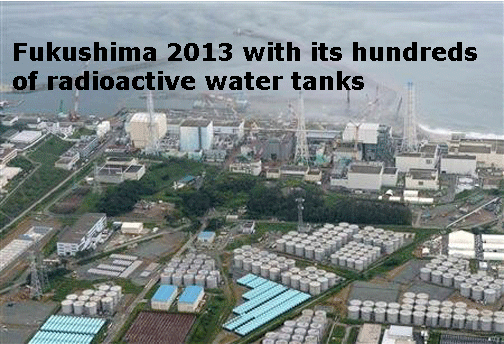Still persistent problems, most
notably 'highly contaminated' water stored in on-site tanks
 The public cost of cleaning up the 2011 Fukushima Daiichi
nuclear plant disaster topped ¥4.2 trillion (roughly $628 billion) as of March,
and is expected to keep climbing, the Japan Times reported on Sunday.
The public cost of cleaning up the 2011 Fukushima Daiichi
nuclear plant disaster topped ¥4.2 trillion (roughly $628 billion) as of March,
and is expected to keep climbing, the Japan Times reported on Sunday.
That includes costs for radioactive decontamination and
compensation payments. Tokyo Electric Power Company (TEPCO) will sell off its
shares to eventually pay back the cost of decontamination and waste disposal,
but the Environment Ministry expects that the overall price of those activities
could exceed what TEPCO would get for its shares.
Meanwhile, the taxpayer burden is expected to increase and TEPCO
is asking for additional help from the government.
The Times reports:
In addition, the
Environment Ministry expects that the cumulative total of decontamination and
related costs could surpass the estimated share proceeds by the March 2017 end
of the current fiscal year.
[....] TEPCO and six other
power utilities charged their customers at least ¥327 billion in electricity
rate hikes after Japan's worst-ever nuclear accident. Moreover, consumers paid
¥219.3 billion or more for TEPCO, chiefly to finance the maintenance of
equipment to clean up radioactive water at the plant and the operation of call
centers to deal with inquiries about compensation payments.
Moreover, as Deutsche Welle noted on Monday, problems still persist at
the nuclear plant, most notably with the "highly contaminated" water
being stored in tanks at the site.
"There are numerous problems that are all interconnected,
but one of the biggest that we are facing at the moment is the highly
contaminated water that is being stored in huge steel tanks at the site,"
Aileen Mioko-Smith, an anti-nuclear activist with the group Green Action Japan,
told DW.
"They are running out of space at the site to put these tanks, the water
that is being generated on a daily basis means they have to keep constructing
more, and the ones that are not welded have a history of leaking."
"The situation with contaminated water at the site is
a ticking time bomb and they don't seem to know what they can do—other than to
construct more tanks," she said.